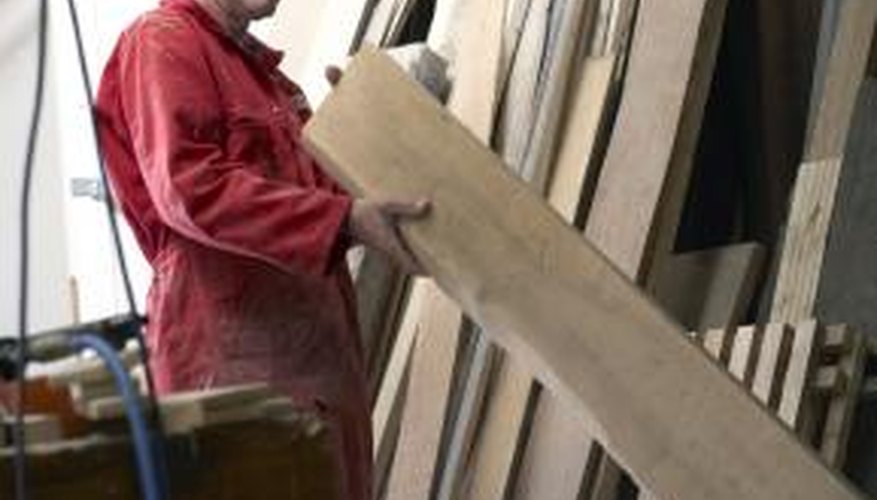Driving a wood screw directly into oak lumber often causes the screw head to strip out or the screw shank to twist apart. Softer wood compacts when screws enter, but dense oak hardwood resists the cutting action of threads. Drilling a starter hole to match the screw diameter solves installation problems, but tannic acid in oak could react with some common metal fasteners, causing disfiguring dark streaks in the wood.
Corrosion Problems
Tannic acid in oak lumber corrodes iron and steel. Oxides leached from rusting metal bleed away from nails and screws, leaving dark stains. Either brass or plated steel screws resist corrosion and don't leave metal stains in oak. Because brass shears easier than steel, working with brass screws in oak requires larger screw diameters. Plated steel screws offer more strength than brass, but for the strongest hardware and best corrosion resistance choose stainless steel screws. Marine quality stainless steel wood screws resist saltwater and chlorides as well as the acids naturally contained in oak.
- Tannic acid in oak lumber corrodes iron and steel.
- Either brass or plated steel screws resist corrosion and don't leave metal stains in oak.
Thread Types
Different thread configurations make some types of wood screws work better in hardwood like oak. Double-thread wood screws require more torque to drive but sink into the wood faster because of a greater pitch angle. The extra turns of thread increase the screw's holding strength in dense hardwood. Double-thread screws actually hold two separate threads cut with the same pitch, so the tip of the screw shows two thread starting points. Since woodworkers drill pilot holes for screws in oak, gimlet tips work well. The screws don't need self-tapping points.
- Different thread configurations make some types of wood screws work better in hardwood like oak.
- Double-thread wood screws require more torque to drive but sink into the wood faster because of a greater pitch angle.
Head Styles
Modern screw head patterns give woodworkers better choices than the traditional Phillips or slot-head screws. Power drills fitted with screwdriver bits set screws accurately and quickly compared to hand tools, but the extra torque of a power drill easily strips out Phillips-head sockets. Power drills driving flat screwdriver bits frequently slip out of the slot, damaging the screw and the workpiece. Square-drive wood screws, with a square socket in the screw head, offer greater strength than older screw styles and stop the drive bit from slipping off the head during use.
- Modern screw head patterns give woodworkers better choices than the traditional Phillips or slot-head screws.
- Power drills fitted with screwdriver bits set screws accurately and quickly compared to hand tools, but the extra torque of a power drill easily strips out Phillips-head sockets.
Pilot Holes
Drilling pilot holes to match wood screws with countersunk heads, a smooth upper section and a threaded lower section, could require three different bits. The longest bit matches the screw length and the root diameter, or the diameter measured at the bottom of the thread. The second drill bit bores a hole to match the smooth part of the screw, or the shank. The third bit countersinks the lip of the hole to match the screw head. Special drill bits made for specific screw sizes and styles bore holes to match all three sections in one operation.
- Drilling pilot holes to match wood screws with countersunk heads, a smooth upper section and a threaded lower section, could require three different bits.
- The longest bit matches the screw length and the root diameter, or the diameter measured at the bottom of the thread.
